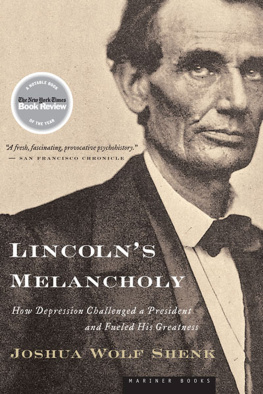Copyright 2014 by Joshua Wolf Shenk
All rights reserved
For information about permission to reproduce selections from this book, write to Permissions, Houghton Mifflin Harcourt Publishing Company, 215 Park Avenue South, New York, New York 10003.
www.hmhco.com
The Library of Congress has cataloged the print edition as follows:
Shenk, Joshua Wolf.
Powers of two : finding the essence of innovation in creative pairs / Joshua Wolf Shenk.
pages cm
ISBN 978-0-544-03159-3 (hardback) ISBN 978-0-544-33446-5 (trade paper) ISBN 978-0-544-26409-0 (trade paper [international edition])
1. Creative ability. 2. Creative thinking. 3. Couples. 4. Artistic collaboration. 5. Teams in the workplace. I. Title.
BF408.S4484 2014
153.3'5dc23
2014011868
e ISBN 978-0-544-03202-6
v1.0814
Illustrations by Josh Ceazan ().
Grateful acknowledgment is made for permission to reprint an image from the following copyrighted work: Figure 1 from Inclusion of Other in the Self Scale and the Structure of Interpersonal Closeness by Arthur Aron, Elaine N. Aron, and Danny Smollan, originally published in the Journal of Personality and Social Psychology, copyright 1992 by the American Psychological Association.
For Mom and Sidney
The world is not comprehensible, but it is embraceable: through the embracing of one of its beings.
Martin Buber
The smallest indivisible human unit is two people, not one; one is a fiction. From such nets of souls societies, the social world, human life springs. And also plays.
Tony Kushner
Note on quotations: When I quote historical figures or non-native English speakers sic, indicating that the language is accurate as rendered, can be assumed throughout. As a general practice, I did not identify the source of quotations in the text, but exhaustive documentation can be found in the notes.
Prelude
On March 29, 1967, around two p.m., John Lennon came to Paul McCartneys house in London, and they headed up to Pauls workroom, a narrow, rectangular space full of instruments and amps and modern art.
The day before, theyd started a new song, meant for Ringo Starr to sing. Today, they intended to finish it off. Hunter Davies, a columnist with the Sunday Times, was on hand, and his account offers a rare window onto how John and Paul worked.
John took up his guitar, and Paul started noodling at the piano. For a couple of hours, Davies wrote, they both banged away. Each seemed to be in a trance until the other came up with something good, then he would pluck it out of a mass of noises and try it himself.
Are you afraid when you turn out the light? John offered.
Paul repeated the line and nodded. They could begin each of the verses with a question, John suggested, and he gave another one. Do you believe in love at first sight?
He interrupted himself. It hasnt got the right number of syllables. He tried breaking the line between believe and in love, putting in a pause long enough to create the right rhythm. It didnt work.
How about, Paul said, Do you believe in a love at first sight? John sang it and instantly added another line. Yes, Im certain it happens all the time. They switched the order of the lines and sang them over and over again:
Would you believe in a love at first sight?
Yes Im certain it happens all the time.
Are you afraid when you turn out the light?
It was now five oclock. Johns wife came by with a friend. They talked about the lines to the song so far, and, in the midst of the chatter, John saidalmost to himselfin answer to whats seen when the light is out: I know its mine. Someone said it sounded smutty.
They chatted some more. Paul started improvising on the piano before breaking into Cant Buy Me Love. John joined in, shouting and laughing. Then they both began to play Tequila, a 1958 hit by the Champs.
Remember in Germany? John said. We used to shout out anything. They did the song again, with John throwing in new words at the crescendo of each line: knickers and Duke of Edinburgh and tit and Hitler.
They both stopped all the shouting and larking around as suddenly as theyd begun it, Davies wrote. They went back, very quietly, to the song they were supposed to be working on. John sang a slight modification of the line theyd agreed on. What do you see when you turn out the light? Then he answered the question. I cant tell you, but I know its mine.
Paul said it would do and he wrote the lines on a piece of exercise paper. Then he wandered around the room. Outside the window, the eyes and foreheads of six girls could be seen as they jumped up and down on the sidewalk on Cavendish Avenue, trying to catch a glimpse over the front wall into Pauls property. John began to play a hymn on the piano. After playing with his sitar, aul went to his guitar, where, Davies wrote, he started to sing and play a very slow, beautiful song about a foolish man sitting on the hill. John listened to it quietly, staring blankly out of the window. Paul sang the song over and over again. It was the first time Paul had played it for John, Davies wrote. There was no discussion.
It was now about seven oclock. They were due soon around the corner at the EMI Studios on Abbey Road. They lit a joint and passed it between them. They decided to call Ringo and tell him they would do the song that night.
Introduction: 1 + 1 = Infinity
For centuries, the myth of the lone genius has towered over us like a colossus. The idea that new, beautiful, world-changing things come from within great minds is now so common that we dont even consider it an idea. These bronze statues have come to seem like old-growth treesmonuments to modern thinking that we mistake for part of the natural world.
We can be forgiven the mistake because creativity is so inexplicable. How, from all the sounds in the universe, from all the syllables and protean rhythms, does a great song arise? How do we account for the emergence of a good ideathe movement from chaos to clarity?
The dominant idea today is that, because creativity resides within the individual, we best expose it by telling stories of those rare geniusesthe ones who made the Sistine Chapel or Hamlet, the light bulb or the iPod. This model basically follows the declaration made by Thomas Carlyle in the 1840s: The history of the world is but the biography of great men.
The most common alternative to the lone-genius model locates creativity in networks. See, for example, Herbert Spencers retort to Carlyle that the genesis of the great man depends on a long series of complex influences. Before he can remake his society, Spencer wrote, his society must make him. Rather than focus on the solitary hero snatching inspiration from the heavens (or the unconscious), this concept emphasizes the long, meandering course of innovation. Instead of heroic individuals, it prioritizes heroic culturesthe courts of sixteenth-century Florence, say, or the coffee shops of Enlightenment London, or the campus of Pixar.
The trouble with the first model of creativity is that its a fantasy, a myth of achievement predicated on an even more fundamental myth of the enclosed, autonomous self for whom social experience is secondary. The lone-genius idea has become our dominant view of creativity not because of its inherent truthin fact, it neglects and obscures the social qualities of innovationbut because it makes for a good story.
The network model has the opposite problem. It is basically true, but so complex that it cant easily be made into narrative. Where the lone-genius model is galvanizing but simplistic, the network model is suitably nuanced but hard to apply to day-to-day life. An argument can be madea rigorous, persuasive argumentthat every good new thing results from a teeming complexity. But how do you represent that complexity in a practical way? How do you talk about it, not just at Oxford or the TED Conference, but in kitchens and bars?
Next page




